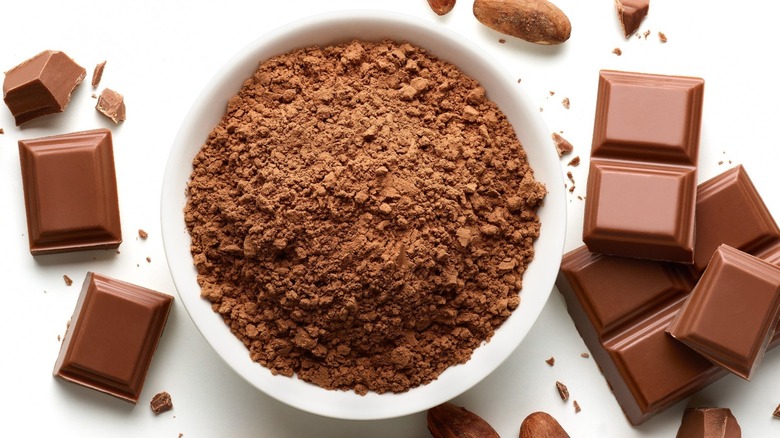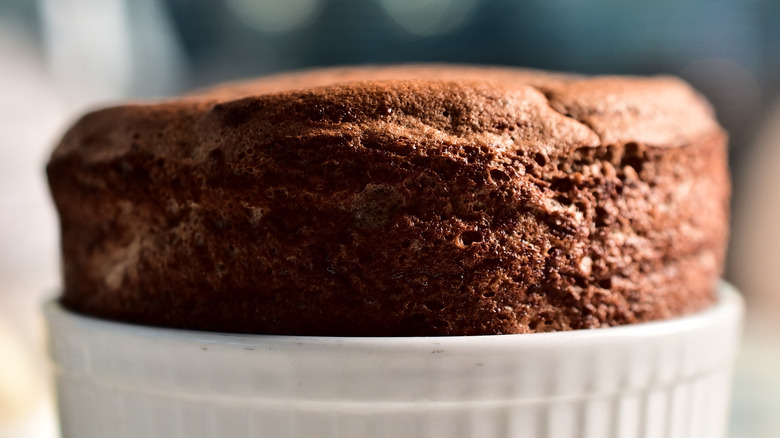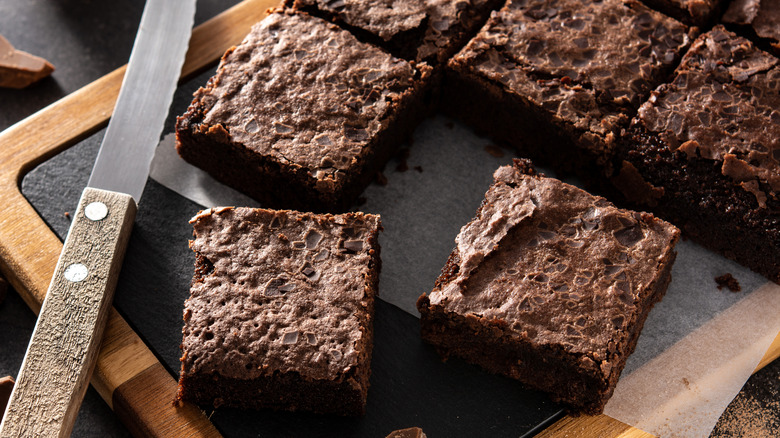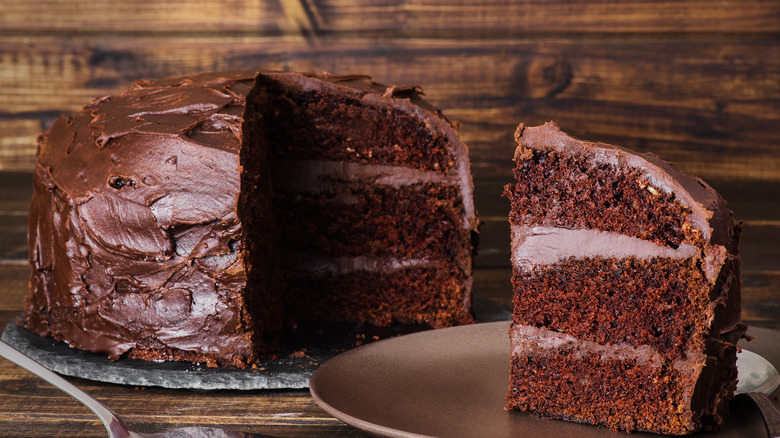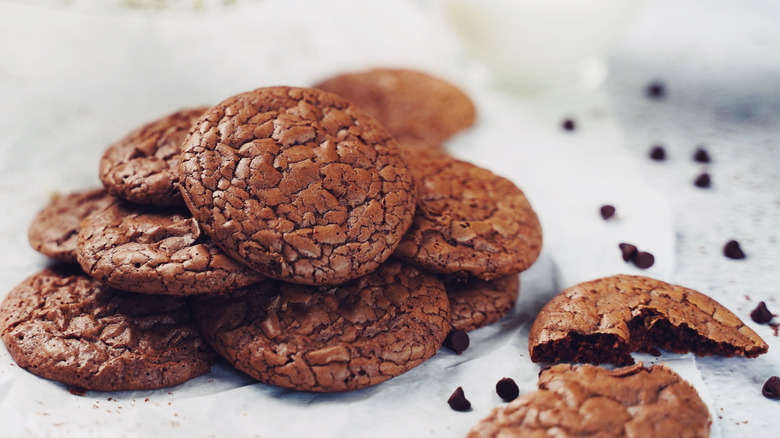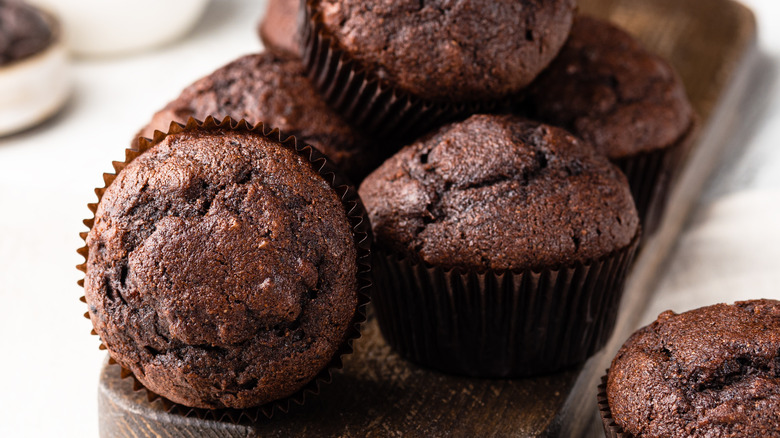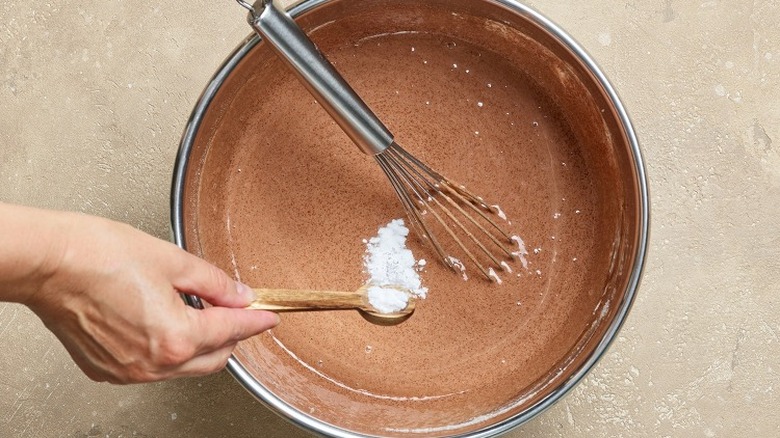Here's When Cocoa Powder Might Be Better For Baking Than Chocolate
Chocolate brownies, chocolate cake, chocolate cookies ... so very many ways to bake with chocolate, and plenty of chocolate baking ingredients to choose from at the store. Cocoa powder is one of the most commonly called-for ingredients, but many recipes also call for melted bar chocolate, which can range from unsweetened baking chocolate to semisweet or milk chocolate.
Besides the obvious difference in how these two types of chocolate look, there is a difference in what each one brings to your recipe, too. According to Fine Cooking, cacao beans are made up of cocoa solids and cocoa butter. The process of creating cocoa powder removes most of the cocoa butter, so it's comprised almost entirely of cocoa solids. As a result, cocoa powder has an intense chocolate flavor – more so than bars of chocolate, which still have cocoa butter. The powdered form also behaves differently in recipes than bar chocolate because it lacks the fats found in cocoa butter, giving recipes noticeable differences in texture and flavor.
The desired look, texture, and flavor in what's being created can help bakers decide which type of chocolate will work the best. Here are examples where cocoa powder might be a better choice than bar chocolate.
Use cocoa powder to coat baking pans for chocolate desserts
One common step when baking cakes, soufflés, and other treats is to grease the pans and then coat them with a dusting of flour. Fine Cooking explains that the flour coating improves the nonstick results by preventing batter from absorbing the grease layer, and it also gives the batter a surface to cling to so it can rise. The downside to coating your pans in flour is that it creates a white film on the surface of chocolate desserts and baked goods, detracting from an otherwise stunning appearance.
One solution is to use cocoa powder to dust the pan. Chef Loic Leperlier told Food & Wine, "When you make a chocolate soufflé or a cake, instead of using sugar or flour to prevent sticking around your mold, use cocoa powder." Grease your pan or mold, like normal, and then add a thin layer of cocoa powder. The cocoa will do the same job as flour of letting the cake or baked treat release cleanly while enhancing the dark and chocolaty surfaces.
Cocoa powder makes brownies that are chewy and tender
Due to its composition, cocoa powder creates a different texture in brownies than you'd get from using bar chocolate. According to Fine Cooking, whether a brownie is tender and chewy or on the firmer side depends on how the chocolate in the recipe interacts with the fats. Cocoa butter is a fat that is firm at room temperature: When bar chocolate is used in a brownie recipe, the cocoa butter becomes firm after baking, making the dessert more solid and fudge-like.
On the other hand, brownie recipes made cocoa powder use fats in the form of oil, which is liquid at room temperature, or butter, which is soft at room temperature. Since cocoa powder has almost no cocoa butter, the butter or oil will determine the texture, and the result is a brownie that's soft but with a little chewiness, too.
Use cocoa powder to create rich and tender cakes
The presence or absence of cocoa butter can make a big difference in the texture and the taste of a chocolate cake. The Kitchn notes that when melted bar chocolate is used, the cocoa butter will become firm again when the cake cools to room temperature, and this can make the texture of the cake seem dry and more solid. Chilled chocolate cakes made with bar chocolate, like this one from Foods Guy, are best served after first reaching room temperature so that the cocoa butter will melt more quickly on the tongue and create a better overall flavor.
Cakes that are made with cocoa powder, which Fine Cooking notes is largely devoid of cocoa butter, have fats in the form of either dairy butter (which holds its shape at room temperature but is very soft) or oil. These cakes, like this Devils Food Cake from Food Network, are very moist and rich. And whether they're served cold or at room temperature, they have lots of chocolate flavor and a tender crumb.
For chewy chocolate cookies, use cocoa powder
To scientifically determine the difference that baking with cocoa powder or bar chocolate makes in cookies (and probably to have an excuse to bake a lot of cookies!) Serious Eats made two batches, identical in every way except one was made with melted chocolate and one with cocoa powder. The cookies made with melted chocolate were more cake-like and "seemed to disintegrate and become sand-like" because the cocoa butter content interfered with the ability of eggs' protein and flour's gluten to help the treats maintain their form. They also didn't taste very chocolaty, since bar chocolate has fewer cocoa solids than an equal amount of cocoa powder.
The cookies made with cocoa powder, however, had a rich chocolate flavor, thanks to the high amount of flavorful cocoa solids. In combination with the butter in the cookie batter, cocoa powder created darker-colored cookies that were moist and had a bit of chewiness as well. Perhaps to get the best of both worlds in your chocolate cookies, you could try using cocoa powder in the batter for a flavorful cookie base, along with a generous handful of chocolate chunks stirred into the batter for extra indulgence in each bite.
Cocoa powder creates more tender quick breads and muffins
Fine Cooking shares that the preferred texture in muffins and quick breads is soft and tender: The batters are mixed in such a way that prevents too much gluten from forming which would create a texture that's tougher. When it comes to chocolate muffins and quick breads, the type of chocolate you use to make batter can also affect the texture.
According to The Kitchn, when used in muffins and quick breads, cocoa powder is a recipe for tenderness. Since it has a very low percentage of cocoa butter, the other fats in the recipe like oil or butter (which are liquid or very soft at room temperature) contribute to the soft and moist texture when baked. If bar chocolate is melted and used to turn these batters chocolaty, the cocoa butter present in the chocolate will become firm again after baking. This means muffins and quick breads would taste drier and be more solid.
But who's to say that a baker can't use cocoa powder in the muffin or quick bread batter to achieve the tender crumb and add chopped chocolate or chocolate chips to get bites of solid goodness in their baked treats?
Cocoa powder can activate baking soda in certain recipes
Food Network shares that in baked goods like cakes, baking soda plays a crucial role: As it activates and creates gas it lifts the batter to create a light and airy texture. However, baking soda can't make this magic happen unless there is an acid present to activate it, and in many chocolate baked goods that acid is the cocoa powder. It does, however, have to be the right type of cocoa powder.
According to The Spruce Eats, when purchasing cocoa powder it will be one of two types: natural or Dutch-process. Natural cocoa (like Hershey's cocoa powder) is more acidic with a stronger flavor, and also has a reddish color that gives the namesake hue to red velvet cake. Dutch cocoa, like this one from Ghirardelli, has been processed to make it less bitter and much less acidic. If your recipe calls for baking soda and cocoa powder (like in this chocolate cake recipe from Taste Of Home,) and there are no other acidic ingredients to activate the baking soda, it's important to use natural cocoa powder with its high acidity. This will give you the best texture in your finished chocolate goodies.
